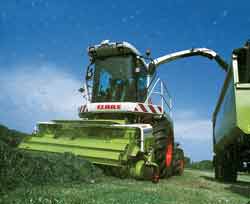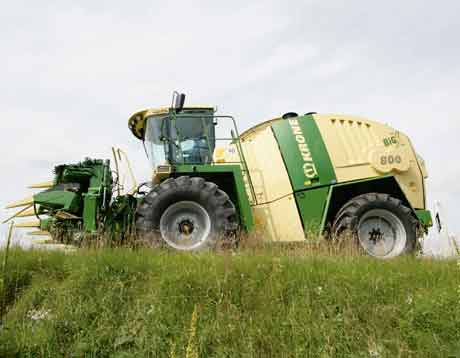Krone Vs Claas: two engines in one machine

Lumping two engines into one machine might seem a crude way of upping forager output but for both Krone and Claas it’s viewed as the most efficient way of boosting power. Nick Fone spoke to one operator with experience of both breeds
In 2005 Krone launched the world’s first twin-engined foragers – the Big X 1000 and 800. Then, two years later, fellow German manufacturer Claas introduced its Jaguar 970 and 980 – also with two engines in the tail.
However, although the concepts were similar, there were two big differences between the machines:
 |
|---|
| Krone’s twin-engined Big X 800 has a monstrous appetite and beefily-built header and chopper. |
To find out just how these differences play out in the field, Farmers Weekly tracked down the only UK contractor to have owned and operated both Krone and Claas harvesters.
It’s fair to say Neil Clarkson knows the silage game. Over the past 25 years he’s cut and cleared vast acreages of grass, maize and wholecrop in and around the Chichester area of West Sussex. An average year will see his forage operation covering between 3500-4000ha (9000-10,000acres).
Up until 2005 he had operated two foragers – Jaguar 890 Speedstars – but it became increasingly apparent that running two gangs wasn’t going to be economically viable for the future, with increasing diesel costs squeezing margins and a shortage of skilled labour becoming a real issue.
“We needed to find a way of moving to a single team and considerably upping output,” explains Neil.
“We weighed up the options and the only real solution I could see was to go down the twin-engine route. At that time the only machine on the market was the Krone Big X so we went for it.”
Foragers Side-by-side | ||
|---|---|---|
| Claas Jaguar 970 | Krone Big X 800 | |
| Power | 730hp | 793hp |
| Engines | 2 x 12.8-litre 6-cyl Mercedes | 1 x 7.2-litre and 1 x 12.8-litre 6-cyl Mercedes |
| Chopping cylinder | 750mm wide x 630mm diameter | 800mm wide x 660mm diameter |
| Plus points | User friendliness Big, wide hydraulic-drive header and crop intake Belt-coupling between two engines Two different size engines Easy access for maintenance Highly sophisticated computer controls All-round visibility | Big, wide haudraulic-drive header and crop intake Two different-size engines Highly sophisticated computer controls Well thought-out 12-row folding maize header |
| Downsides | Grass header limits output Lack of ‘give’ in rigid engine-to-engine gearbox coupling Fuel tank won’t run all day High overall weight Corn-cracker issues Poor visibility Slower field times | Lack of “give in rigid engine-to-engine gearbox coupling High overall weight Poor visibility |
With its two Mercedes straight sixes linked through a gearbox coupling driving the chopper, blower and hydrostatic transmission, the Krone was something of a revolution. The beefy hydraulic header and intake roller drives gave infinite, independent variability – a real plus point for uneven crops.
“In the first season we had a vertical-fold 10-row maize header. It was a nightmare on the road but once you got in the field it was unstoppable.
“The following year we got a prototype double-folding 12-row header that was so much better to travel with and slowed the Big X down a bit, thankfully for the trailer drivers.”
“But the Krone’s real strength is the build of the intake. You only have to look at the springs on the rollers to realise how robust it is.”
Output had increased so much that it became necessary to run two loading shovels on the clamp. A pair of JCB Farm Master 414s worked side-by-side to ensure the forager was never kept waiting in the field.
The Krone had achieved Mr Clarkson’s goal of upping output and allowing him to streamline the forage operation but as with all new machines, it had had its issues.
After a year’s work the strain of handling two engines rigidly linked together by a single gearbox had taken its toll on the driveline. By then Claas had launched its new twin-engined Jaguar so he decided it was time to give his old favourite another shot.
“I liked Claas’s approach of using a belt to link the two engines – it gives that little bit more tolerance, should torque loadings or speeds vary. The Jaguar is more compact, making visibility vastly better and Claas machines are just so familiar and easy to use,” he explains.
“The back-up we had received from Sussex Harvest Centre over the years was second-to-none and going back to that was a real deal clincher for me.”
One year on, the Jaguar 970 has proved itself to be a reliable performer, although it too has its weaknesses.
“The Claas is about 50hp less powerful than the Krone but it still manages the same output.
“It seems to lose less power through the hydro units than the Big X and although it uses the same Merc engines, they seem to be mapped differently – you definitely get more torque out of the Jag.”
Although having two engines of identical power might reduce the strain on the driveline, it means the Claas isn’t as versatile as the Krone. With the BigX’s power plants pumping out about 500hp and 300hp, respectively, it was possible to run just the larger one in lighter crops – with the Jaguar there isn’t enough muscle from just one engine.
With its bigger, heavier build, the Krone chopping cylinder was distinctly better at resisting damage from foreign objects and in 7000ha (18,000acres) it never once threw a blade, whereas the previous Claas 890s has a tendency to lose them when they swallow something nasty.
That said, Mr Clarkson is convinced he has made the right decision in swapping back to Claas, although he’d like to see the company learning a few lessons from the competition.
“If you took the header, feed-rollers and chopper from the BigX and mated them with the Jag’s blower, spout, cab, engine and driveline, you’d have the perfect forager.”
| NT Clarkson Forage Services |
|---|
| Work undertaken: All arable work incl. stubble-to-stubble contracts, grass, maize and wholecrop silage plus baling, muck and compost spreading Tractors: 4 x NH T6080s, 12 x NH T7040s, 3 x T7060s and 1 x T8050 Combines: 2 x NH CX8070s Loaders: JCB 434 and 414 Farm Masters, 2 x NH LM 5060 telehandlers Sprayer: 3000-litre Sands with 24m booms Forager: Claas Jaguar 970 Mower: Krone Big M 400 Trailers: 9 x Bailey 16-tonners Muck spreaders: Three Rolland 14t plus two 16t Rolland TCE compost spreaders Balers/wrappers: MF185 & MF2170; 2x McHale 998 wrappers Drills: 6m Vaderstad Rapid plus 3 x 4m power-harrow combis Staff: Five full-time plus 15-18 others at peak times |

